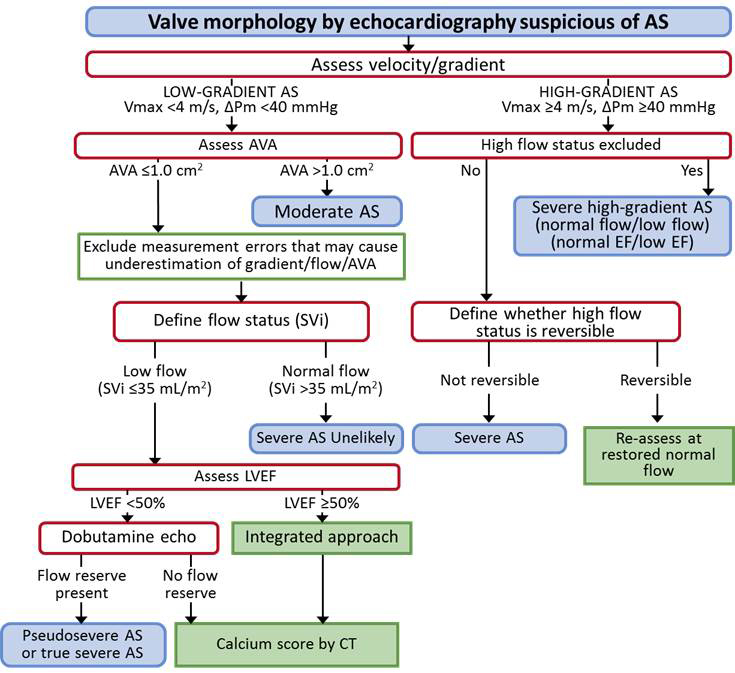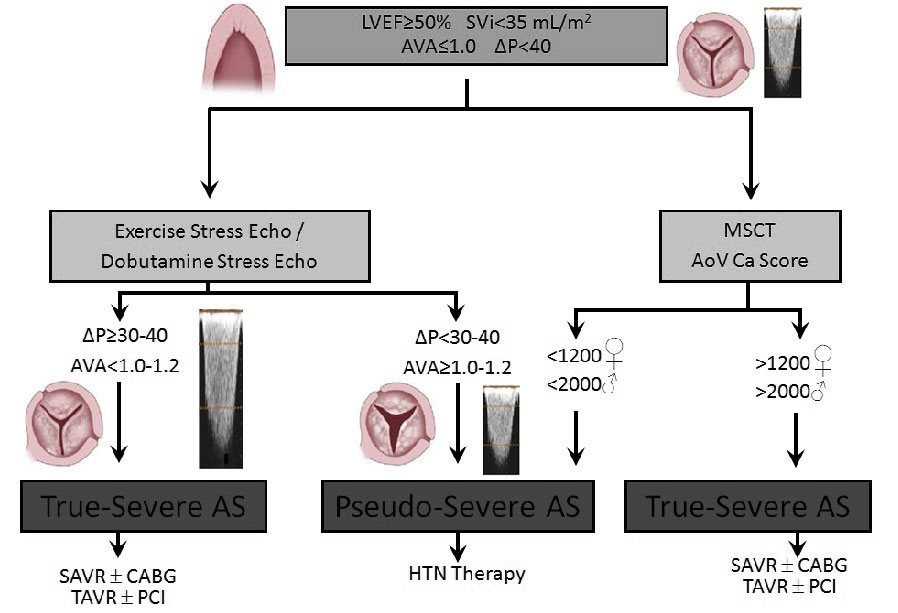With this hemodynamic presentation it is difficult to distinguish true aortic valve stenosis where the primary culprit is severe aortic valve diseaseAuthor. A squared function of flow and may thus be pseudo-normalized and underestimate stenosis severity in presence of low flow.

Pdf Low Gradient Aortic Stenosis Semantic Scholar
The guidelines also acknowledge that lower gradients may be observed in.

. LFLG pattern is seen in 515 of patients with severe AS and is more prevalent in women and elderly patients. Low-flow Low- gradient LFLG aortic stenosis in patients with a depressed LV ejection fraction. The most inclusive is an effective orifice area 10 cm 2 9 10 11 LV ejection fraction 40 and mean pressure difference 30 mm Hg.
The multicenter TOPAS Truly or Pseudo-Severe Aortic Stenosis study. Authors Eric Awtry 1 Ravin Davidoff. Highlights in this focused update on aortic stenosis document include.
Low-flow low-gradient severe aortic stenosis AS is characterised by a small aortic valve area AVA and low mean gradient MG secondary to a low cardiac output and may occur in patients with either a preserved or reduced left ventricular ejection fraction LVEF. 40 ms a mean gradient 40 mm Hg or an aortic valve area. 1 When a severe AS becomes symptomatic the rate of death is 50 at 2 years unless valve replacement is performed.
High gradient severe AS The 2020 American Heart AssociationAmerican College of Cardiology valvular heart disease guidelines identify severe aortic stenosis AS by the presence of an aortic transvalvular velocity 4 ms andor mean transvalvular pressure gradient 40 mmHg. This entity is defined as an LVEF 50 the presence of a low flow stroke volume index aortic valve gradient. Various diagnostic modalities are needed to accurately determine the severity of aortic stenosis and potential treatment benefit.
New classification of AS by gradient flow and ejection fraction. Low gradient low flow aortic stenosis has been defined in the literature by a variety of different cut points. Aortic valve replacement AVR if.
Severe aortic stenosis is defined as an aortic valve effective orifice area AVA 10 cm2 or 06 cm2 if indexed for body surface area and a mean transvalvular gradient 40 mmHg. 815 and guidelines 2 recommend classifying patients with small AVA and preserved LVEF into 4 groups according to their levels offlow ie SVi. 5 11 12 In such patients the first step must be to recognise that the aortic stenosis could be severe.
Low-flowlow-gradient aortic stenosis. AS grading algorithm- an integrated and stepwise approach. The second step is to distinguish pseudo-severe from true severe AS TSAS.
Important is to note that gradients are a. Practice Guidelines as Topic. Aortic stenosis AS is defined as a peak aortic jet velocity.
AVA. In the American Heart AssociationAmerican College of Cardiology and European Society of CardiologyEuropean Association of Cardiothoracic Surgery guidelines 12 severe aortic stenosis AS is defined as a peak aortic jet velocity 40 ms a mean gradient 40 mm Hg or an aortic valve area AVA. Projected valve area at normal flow rate improves the assessment of stenosis severity in patients with low-flow low-gradient aortic stenosis.
Low flow is defined in the guidelines as a stroke volume index transvalvular pressure gradient is highly flow-dependent ie. In the American College of CardiologyAmerican Heart Association guidelines the criteria for severe aortic stenosis are an effective orifice area less than10 cm or less than 06 cmm a transvalvular mean gradient greater than 40 mmHg and a peak aortic jet velocity greater than 40 ms. About 60 of patients with paradoxical low-flow low-gradient PLF-LG aortic stenosis AS have a severe disease that justifies aortic valve replacement AVR.
In the Western population prevalence increases exponentially with age resulting in a prevalence of 98 in octogenarians. The first step in patients with symptomatic PLF AS should be to rule out measurement errors and treat hypertension. Symptomatic patients presenting with low-flow low-gradient severe AS have a dismal prognosis independent of.
Association of Cardiothoracic Surgery guidelines12severe. The diagnosis of NFLG severe. Valvular aortic stenosis AS is the most frequently observed valvular heart disease.
Low flow low gradient aortic stenosis with preserved LVEF. Current guidelines restrict a dobutamine valvular stress test to limited clinical circumstances. Management of Paradoxical Low-Flow Low-Gradient Aortic Stenosis Need for an Integrated Approach Including Assessment of Symptoms Hypertension and Stenosis Severity.
The aortic valve area AVA is typically 1 cm 2 with AVA indexed to body surface. Affiliation 1 Section of Cardiology. Low-flowlow-gradient aortic stenosis Circulation.
4 rows Approach to normal-flow low-gradient aortic valve stenosis. Low-flow low-gradient aortic stenosis is a difficult entity to diagnose and treat. However as many as 30 of patients who have a calculated AVA in the severe range have other parameters suggesting mild or moderate disease ie mean gradient low-flowlow-gradient AS LFLGAS may truly have severe AS with resultant myocardial failure true AS or may have more moderate degrees of AS and unrelated.
LF LG AS is characterized by combination of severe aortic valve stenosis calculated aortic valve area AVA low transvalvular gradient mean gradient low flow stroke volume 35 mlm 2. Low flow low gradient aortic stenosis with reduced LVEF. True-severe classical and paradoxical low-flow low-gradient aortic stenosis can be distinguished from pseudo-severe aortic stenosis by dobutamine stress.
On the other hand the AVA may be. Recognizing low flow low gradient AS is imperative because it is not only common with approximately 35-40 of patients with severe AS presenting with a low mean gradient Low flow low gradient AS is further characterized by a dobutamine stress test but that is.

Paradoxical Low Flow Low Gradient Aortic Stenosis Circulation

Normal Flow Low Gradient Severe Aortic Stenosis Myth Or Reality Structural Heart

Simplifying The Approach To Classical Low Flow Low Gradient Severe Aortic Stenosis A Renewed Emphasis On The Resting Transthoracic Echocardiogram International Journal Of Cardiology

Confirmation Of Aortic Stenosis Severity In Case Of Discordance Between Aortic Valve Area And Gradient Sciencedirect

Pdf Low Gradient Aortic Stenosis Semantic Scholar

What Is New For General Cardiologists In The 2017 Esc Guidelines On Valvular Heart Disease

Pdf Assessment Of Low Flow Low Gradient Aortic Stenosis Multimodality Imaging Is The Key To Success Semantic Scholar

Low Flow Low Gradient Aortic Stenosis When Is It Severe American College Of Cardiology

Progression Of Normal Flow Low Gradient Severe Aortic Stenosis With Preserved Left Ventricular Ejection Fraction American Journal Of Cardiology

Low Gradient Severe Aortic Stenosis With Preserved Ejection Fraction A Comprehensive Approach To The Individual Patient With Symptoms Is Key American College Of Cardiology

Distinction Of Classical And Paradoxical Low Flow Low Gradient Download Scientific Diagram

Figure 6 From Low Gradient Aortic Stenosis Semantic Scholar

Low Flow Low Gradient Aortic Stenosis When Is It Severe American College Of Cardiology

Proposed Algorithm For Assessment Of Patients With Low Flow Download Scientific Diagram

Evaluation And Management Of The Patient With Low Flow Low Gradient Download Scientific Diagram

Diagnostic Workup And Therapeutic Management Of Paradoxical Low Flow Download Scientific Diagram

Complex Scenarios Paradoxical Low Gradient As In Normal Patients

Dobutamine Stress Echocardiography In Low Flow Low Gradient Aortic Stenosis Flow Reserve Does Not Matter Anymore Journal Of The American Heart Association
